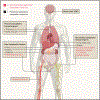Curing HIV: Seeking to Target and Clear Persistent Infection
- PMID: 32220311
- PMCID: PMC7896558
- DOI: 10.1016/j.cell.2020.03.005
Curing HIV: Seeking to Target and Clear Persistent Infection
Abstract
Human immunodeficiency virus type 1 (HIV-1) infection persists despite years of antiretroviral therapy (ART). To remove the stigma and burden of chronic infection, approaches to eradicate or cure HIV infection are desired. Attempts to augment ART with therapies that reverse viral latency, paired with immunotherapies to clear infection, have advanced into the clinic, but the field is still in its infancy. We review foundational studies and highlight new insights in HIV cure research. Together with advances in ART delivery and HIV prevention strategies, future therapies that clear HIV infection may relieve society of the affliction of the HIV pandemic.
Copyright © 2020 Elsevier Inc. All rights reserved.
Conflict of interest statement
Declaration of Interests J.J.E. reports grants and personal fees from Merck and personal fees from Gilead outside of the submitted work. D.M.M. reports personal fees from Merck and ViiV Healthcare and holds common stock in Gilead. C.L.G. reports research grants from Viiv and Gilead.
Figures




References
-
- Okoye A, R.F., Brehm J, Maxwell A, Vaidya M, Pardons M, Tai V, Tang J, Smedly J, Axthelm M, Lifson J, Picker L, Trautmann L, Favre D, Chomont N. Activation of latent HIV and SIV RNA transcription in vitro and in vivo in ART suppressed SIV-infected rhesus macaques by the Ingenol-based protein kinase C agonist, GSK445A. In AIDS 2018. (Amsterdam, Netherlands).
Publication types
MeSH terms
Substances
Grants and funding
LinkOut - more resources
Full Text Sources
Medical

